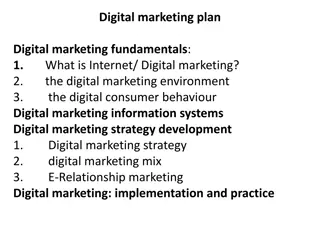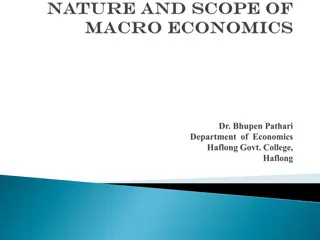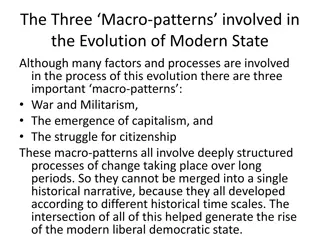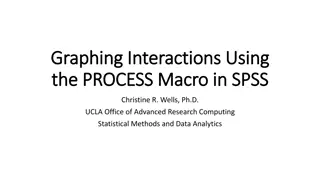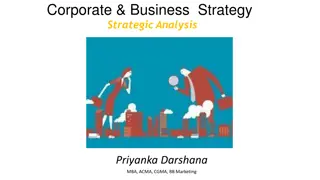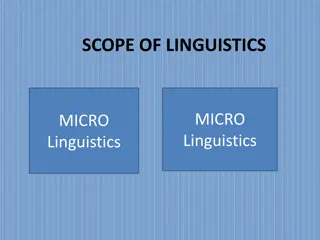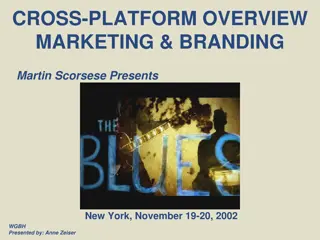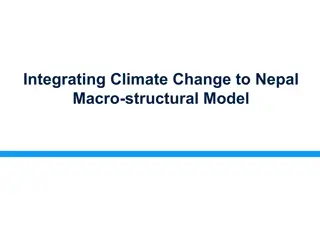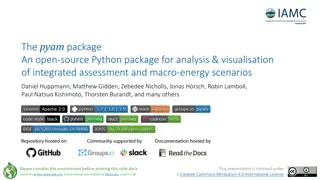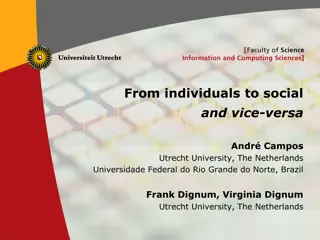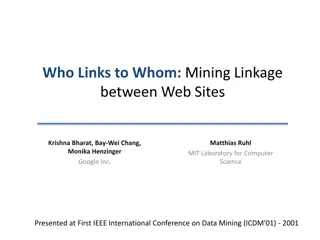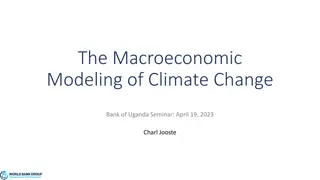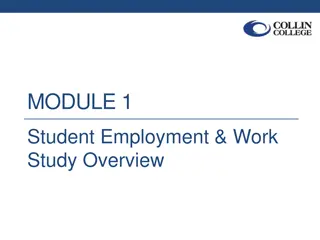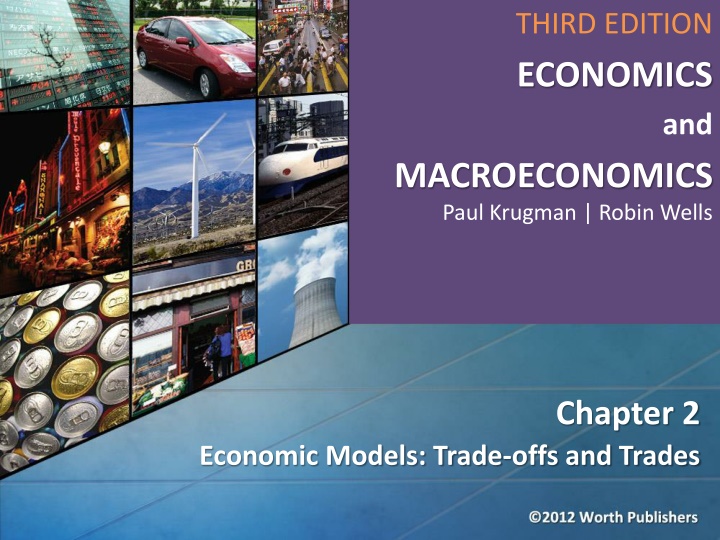
Economic Models & Trade-offs in Macroeconomics
Explore the significance of economic models, trade-offs, and production possibility frontier in understanding real-life economic scenarios. Learn about positive versus normative economics, agreement among economists, and the impact of economic growth on production possibilities.
Download Presentation

Please find below an Image/Link to download the presentation.
The content on the website is provided AS IS for your information and personal use only. It may not be sold, licensed, or shared on other websites without obtaining consent from the author. If you encounter any issues during the download, it is possible that the publisher has removed the file from their server.
You are allowed to download the files provided on this website for personal or commercial use, subject to the condition that they are used lawfully. All files are the property of their respective owners.
The content on the website is provided AS IS for your information and personal use only. It may not be sold, licensed, or shared on other websites without obtaining consent from the author.
E N D
Presentation Transcript
THIRD EDITION ECONOMICS and MACROECONOMICS Paul Krugman | Robin Wells Chapter 2 Economic Models: Trade-offs and Trades
Why models? Simplified representations of reality play a crucial role in economics Two simple but important models: production possibility frontier circular-flow diagram The difference between positive economics and normative economics When economists agree and why they sometimes disagree WHAT YOU WILL LEARN IN THIS CHAPTER
Models in Economics A model is a simplified representation of a real situation that is used to better understand real-life situations. How? By Creating a real but simplified economy Example: cigarettes in World War II prison camps Simulating an economy on a computer Examples: tax models, money models The other things equal assumption means that all other relevant factors remain unchanged.
Trade-offs: The Production Possibility Frontier The production possibility frontier (PPF) illustrates the trade-offs facing an economy that produces only two goods. It shows the maximum quantity of one good that can be produced for any given production of the other good. The PPF improves our understanding of trade-offs by considering a simplified economy that produces only two goods by showing this trade-off graphically.
Economic Growth Economic growth results in an outward shift of the PPF because production possibilities are expanded. Production is initially at point A (20 small jets and 25 Dreamliners), it can The economy can now produce more of everything. move to point E (25 small jets and 30 Dreamliners).
United States and Brazilian Opportunity Costs U.S. Brazilian Opportunity Cost Opportunity Cost One small jet 3/4 large jet > 1/3 large jet One large jet 4/3 small jets < 3 small jets
Specialize and Trade Both countries are better off when they each specialize in what they are good at and then trade. It s a good idea for Brazil to make the small jets for both of them, because its opportunity cost of a small jet in terms of large jet not made is only 1/3 of a large jet, versus 3/4 large jets for the United States. Correspondingly, it s a good idea for the United States to make large jets for both of them.
How the Two Countries Gain from Trade Both the United States and Brazil experience gains from trade: U.S. consumption of large jets increases by two, and its consumption of small jets increases by four. Brazilian consumption of large jets increases by two, and his consumption of small jets increases by four.
Comparative vs. Absolute Advantage An individual has a comparative advantage in producing a good or service if the opportunity cost of producing the good is lower for that individual than for other people. An individual has an absolute advantage in an activity if he or she can do it better than other people. Having an absolute advantage is not the same thing as having a comparative advantage.
U.S. vs. Brazil Absolute vs. Comparative The United States has an absolute advantage in both activities: it can produce more output with a given amount of input (in this case, its time) than Brazil. But we ve just seen that the United States can indeed benefit from a deal with Brazil because comparative, not absolute, advantage is the basis for mutual gain.
U.S. vs. Brazil Absolute vs. Comparative So Brazil, despite its absolute disadvantage, even in small jets, has a comparative advantage in small jet making. Meanwhile the United States, which can use its time better by making large jets, has a comparative disadvantage in small jet making.
Transactions: The Circular-Flow Diagram Trade takes the form of barter when people directly exchange goods or services they have for goods or services they want. The circular-flow diagram is a model that represents the transactions in an economy by flows around a circle.
Circular-Flow of Economic Activities A household is a person or a group of people that share their income. A firm is an organization that produces goods and services for sale. Firms sell goods and services that they produce to households in markets for goods and services. Firms buy the resources they need to produce goods and services factors of production in factor markets.
Circular-Flow of Economic Activities Ultimately, factor markets determine the economy s income distribution how total income is divided among the owners of the various factors of production.
Using Models Positive economics is the branch of economic analysis that describes the way the economy actually works. Normative economics makes prescriptions about the way the economy should work. A forecast is a simple prediction of the future.
Using Models Economists can determine correct answers for positive questions, but typically not for normative questions, which involve value judgments. The exceptions are when policies designed to achieve a certain prescription can be clearly ranked in terms of efficiency. It is important to understand that economists don t use complex models to show how clever they are, but rather because they are not clever enough to analyze the real world as it is.
When and Why Economists Disagree There are two main reasons economists disagree: 1. Which simplifications to make in a model 2. Values
VIDEO TED Video: http://globaltransition2012.org/2012/01/tim-jackson- on-prosperity-without-growth/ Prof. Tim Jackson on the principles for a new economy and tradeoffs
SUMMARY 1. Almost all economics is based on models. An important assumption in economic models is the other things equal assumption, which allows analysis of the effect of a change in one factor by holding all other relevant factors unchanged.
SUMMARY 2. One important economic model is the production possibility frontier. It illustrates: opportunity cost, efficiency, and economic growth. There are two basic sources of growth: an increase in factors of production resources such as land, labor, capital, and human capital, inputs that are not used up in production and improved technology.
SUMMARY 3. Another important model is comparative advantage, which explains the source of gains from trade between individuals and countries. Everyone has a comparative advantage in something. This is often confused with absolute advantage, an ability to produce a particular good or service better than anyone else.
SUMMARY 4. In the simplest economies, people barter or trade goods and services for one another rather than trade them for money, as in a modern economy. The circular-flow diagram represents transactions within the economy as flows of goods, services, and money between households and firms. These transactions occur in markets for goods and services and factor markets.
SUMMARY 5. Economists use economic models both for positive economics, which describes how the economy works, and for normative economics, which prescribes how the economy should work. Positive economics often involves making forecasts. Economists can determine correct answers for positive questions, but typically not for normative questions, which involve value judgments.
SUMMARY 5. There are two main reasons economists disagree. One: they may disagree about which simplifications to make in a model. Two: economists may disagree like everyone else about values.
KEY TERMS Model Other things equal assumption Production possibility frontier Factors of production Technology Comparative advantage Absolute advantage Barter Circular-flow diagram Household Firm Markets for goods and services Factor markets Income distribution Positive economics Normative economics Forecast Specialization Equilibrium Efficient Equity

